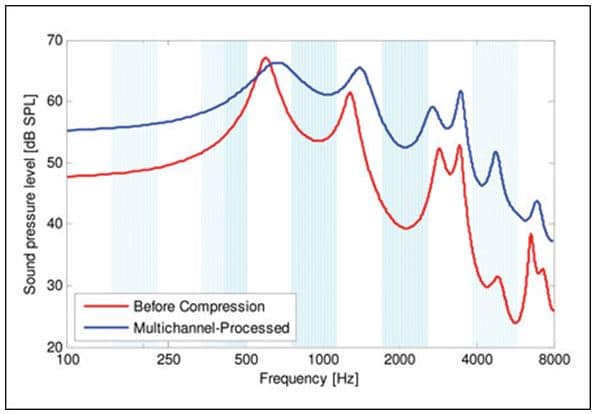The defensibility of tiered pricing linked to number of hearing aid channels is scrutinized in a two-part post series by Amyn Amlani, PhD.
Manufacturers engineer contemporary hearing aids with different levels of technology. The basis for the differing technology levels is based primarily on the number of channels (i.e., a range of frequencies that allows for electroacoustic adjustment by means of a digital filter or series of filters).
The primary advantages of a multichannel system to the practitioner, when compared to a single channel system, include:
- Increased ability to provide varying amounts of amplification (i.e., wide-dynamic range compression (WDRC) depending on the hearing thresholds and dynamic range of the listener.{{1}}[[1]] Villchur E. (1973). Signal processing to improve speech intelligibility in perceptive deafness. Journal of the Acoustical Society of America, 53, 1646–1657.[[1]]
- The ability to improve the hearing aid fitting using channel-specific technological features, such as noise reduction,{{2}}[[2]]Bentler R, Chiou LK. (2006). Digital noise reduction: an overview. Trends in Amplification, 10(2), 67-82.[[2]] feedback cancellation,{{3}}[[3]]Chalupper J, Powers TA, Steinbuss A. (2011). Combining phase cancellation, frequency shifting, and acoustic fingerprint for improved feedback suppression. Hearing Review, 18(1), 24-29.[[3]] and directionality.{{4}}[[4]]Christensen LA (2013). The evolution of directionality: Have developments led to greater benefit for hearing aid users? Hearing Review, 20(11).[[4]]
Hearing Aid Pricing By Number of Channels
To the patient, increasing the number of hearing aid channels typically results in an increase retail price. That is, the fewer channels available in a product are associated with a lower retailer price (and often fewer technological features), while devices having greater channels are correlated with a higher retail price (and often more technological features).
Thus, the present pricing model conjectures that increasing the number of channels provides the listener with improved aided performance. Unfortunately, the literature does not support this assumption. In this blog, the reader is presented with acoustic, behavioral, and psychological evidence, highlighting potential diminished listening performance from increasing the number of channels in a hearing aid. A discussion of a future pricing strategy is also provided.
Acoustical Analysis
Research shows that increasing the number of channels in a device does not always result in improved speech-recognition performance for the hearing aid user.{{5}}[[5]]Souza PE (2002). Effects of compression on speech acoustics, intelligibility, and sound quality. Trends in Amplification, 6, 131-165.[[5]],{{6}}[[6]]Amlani AM. (2008, March). Multichannel compression hearing aids: Perceptual considerations. The Asha Leader, 13(3), 12-20.[[6]] One explanation for the decrease in aided speech-recognition performance stems from the notion that a hearing aid with WDRC flattens the spectral contrast, or peak-to-valley ratio, of the input signal’s formant structure.{{7}}[[7]]Plomp R. (1988). The negative effect of amplitude compression in multichannel hearing aids in the light of the modulation-transfer function. Journal of the Acoustical Society of America, 83, 2322-2327.[[7]]

Figure 1. An illustration of the speech envelope for the vowel /u/ for an unamplified input signal (in red) and the signal processed in a multichannel WDRC device (in blue). Adopted from Schaub (2009).
The effect is illustrated in Figure 1 for the vowel /u/.{{8}}[[8]]Schaub A. (2009). Enhancing temporal resolution and sound quality: A novel approach to compression. Hearing Review, 16(8), 28-33.[[8]] Bor et al{{9}}[[9]]Bor S, Souza P, Wright R. (2008). Multichannel compression: effects of reduced spectral contrast on vowel identification. Journal of Speech-Language Hearing Research, 5, 1315-1327.[[9]] and Amlani et al (2011) {{10}}[[10]]Amlani AM, Bharadwaj SV, Jivani S, Pogue J. (2011). Spectral contrast analyses of vowels processed through a multichannel simulated hearing aid. Journal of the Acoustical Society of America, 130 (4, Pt 2), 2448-2249.[[10]] investigated the influence of multichannel WDRC having 2, 4, 8, and 16 channels on the spectral contrast of vowels. Both studies demonstrated an inverse relationship between spectral contrast and number of channels; as the number of compression channels increases, the spectral contrast of vowels is decreased.
What about the effect of multichannel WDRC on the spectral contrast of consonants? In an extension of the work by Amlani et al (2011), Jivani and colleagues{{11}}[[11]]Jivani SJ, Amlani AM, Bharadwaj SV. (2012). Impact of multichannel compression on vowel and consonant identification. Poster presentation, American Academy of Audiology, Boston, Massachusetts.[[11]] assessed the impact of multichannel WDRC having 2, 4, 8, and 16 channels on the initial consonant in a /CVC/ syllable. The initial consonants were /p, t, k, b, d, g, s, ʃ/. Results revealed that consonants processed through a 2-channel device provided statistically (p < .05) the least degraded spectral contrast of the adjacent vowel, compared to a device having 8- and 16-channels.
Other Lines of Evidence
Next week’s post will summarize empirical and theoretical effects of multichannel processing on behavioral performance, willingness to pay, and cognitive load.
**Read Part 2 here
Amyn M. Amlani, Ph.D., is an Associate Professor on the faculty of the Department of Speech and Hearing Sciences, University of North Texas. Dr. Amlani holds the B.A. degree in Communication Disorders from the University of the Pacific, the M.S. degree in Audiology from Purdue University, and the Ph.D. degree in Audiology/Psychoacoustics (minor in Marketing and Supply Chain Management) from Michigan State University. His research interests include the influence of hearing aid technology on speech and music; economic and marketing trends within the hearing aid industry; and playing bass guitar with The Moonlighters, a heavy metal cover band. E-mail: [email protected]
feature image courtesy of design boom








